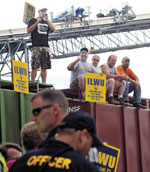
Showdown on West Coast Docks: The Battle of Longview
(November 2011).
click on photo for article
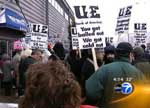
Chicago Plant Occupation Electrifies Labor
(December 2008).
click on photo for article
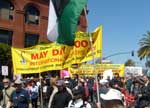
May Day Strike Against the War Shuts
Down
U.S. West Coast Ports
(May 2008)
click on photo for article

November 2013
Break with the Democrats! Defend the Right to Strike!
Lessons of the On-Again,
Off-Again BART Strike
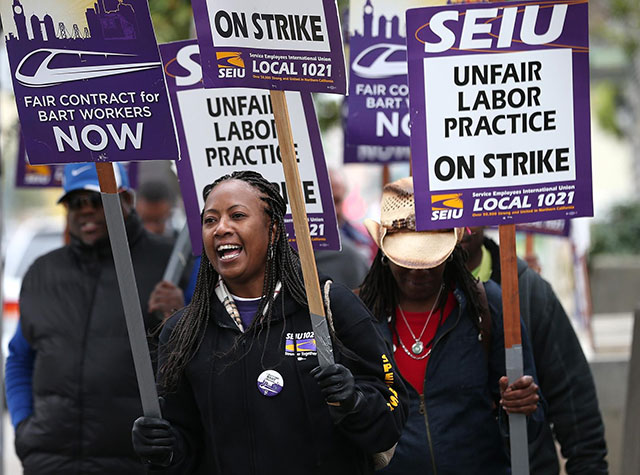
Striking Bay Area Rapid Transit (BART) workers outside the Lake Merritt station on October 21. What was needed was to mobilize Bay Area labor to shut down all cross-bay transportation. (Photo: Justin Sullivan/Getty Images)
What It Would Take to
Win: A Class-Struggle Leadership
and Solid Labor Action to Shut Down Bay Area
Transportation
Transit workers in the Bay Area recently faced one of the most vicious attacks on workers since Wisconsin Republicans teamed up with their allies the Democrats in 2011 to gut the public sector unions. After making $100 million givebacks in 2009 and going without raises for four years, Bay Area Rapid Transit system workers were hit with serious cutbacks to staffing and safety standards. After an initial walkout in July, which was abruptly called off without a membership vote, as tension built with one “fact-finding” and “cooling-off” delay after another and the employer refused to budge from its take-back demands, BART workers were demonized by the rabidly anti-union media for alleged laziness, lack of education and greedy entitlement.
Finally, on Friday, October 18, after a week of on-again, off-again strike warnings, the unions at BART walked out. Hard-nosed management negotiators essentially forced their hand. Even though negotiators for Amalgamated Transit Union Local 1555 and Service Employees International Union Local 1021 had already caved in to BART’s economic giveback demands, and proposed to submit massive work rules changed to binding arbitration, that was not enough for the bosses. So, backed into what promised to be a lengthy strike, which they never wanted, did everything to avoid and were not prepared to wage, the ATU and SEIU tops felt they had no choice: it was that or total surrender.
But then, on the second day of the strike, everything
changed in a flash when a train driven by inexperienced
scabs killed two strikebreaking engineers inspecting the
tracks (see box). This dramatically confirmed what the
unions had been saying about the dangers of BART’s plans
for scab operations, and of management’s demands for
junking safety rules. “Public opinion,” which had been
whipped into an anti-union frenzy, suddenly turned. So did
the ATU and SEIU leaders toughen their stance in response?
No, instead they called off picketing to mourn the dead as
part of the “BART family”! And then on Monday they signed
a contract with all the concessions on pay and hours, and
letting management introduce new technology without union
approval.
Death on the
Tracks: Strikebreakers Killed
by BART Management’s Unsafe Operations
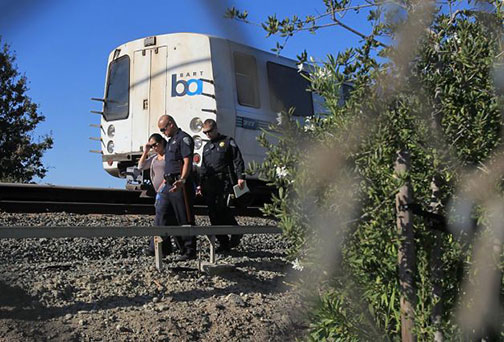
Police at site near Walnut Creek where two were killed by scab train, Oct. 19.
(Photo: Leah Mills/San Francisco Chronicle)
The deaths on Saturday, October 19 of two BART employees, an engineer and a “contractor” who were scabbing on the day-old BART strike, dramatically underlined the stakes in this critical labor battle. The two were inspecting tracks north of the Walnut Creek station when they were struck and killed by a train supposedly on “maintenance run,” according to management.
In fact, according to a source quoted in an “Insider” report in the San Francisco Chronicle (21 October), there were as many as a half dozen people on board and “They were practicing training people how to operate and have the skills in the event of an extended strike.” This was later confirmed by an investigator of the National Transportation Safety Board (NTSB).
So after provoking the strike with demands for work rule changes, BART managers proceeded to train scabs and to kill scabs!
And to cover it up they lied. BART issued a statement saying that the dead employees had “extensive experience” in working around trains, and that an “experienced operator” was at the train controls. Yet the train was running under computer control at the time. A recording of BART radio communications had someone (a scab) announcing that there were “no personnel wayside,” only to be contradicted by another voice a few seconds later.
The bosses are no more concerned for truth and accuracy than they are for human life.
Grace Cruncian, the general manager of the transit system, issued a prepared statement saying, “The entire BART family is grieving.” What “family”?! This was not some unforeseeable accident. Transportation is one of the most dangerous industries in the country, with heavy equipment and electrified rails. Using inexperienced personnel is bound to result in tragedies.
BART management was guilty of murdering its own strikebreaking employees in its determination to break the unions. But there’s not a chance the murderers will go to jail.
Even the big business press had to admit that, “Despite repeated warnings from union officials that managers would create a dangerous situation by operating trains, BART management had earlier assured the public that those operators were certified, safe” and would provide scab operations (Oakland Tribune, 20 October). Nevertheless, the union-bashing media kept pushing for managers’ “flexibility to schedule people as they see fit” (Sonoma Press-Democrat, 19 October).
So BART bosses “saw fit” to run trains with unqualified scabs, and the result was two dead.
Under fire, management announced that it was “suspending” the “simple approval” procedure under which workers on the tracks received no warning at all of approaching trains. But it is threatening to cut night-time service in response, and while crying poverty in wage bargaining, BART stubbornly resisted Cal/OSHA’s call to end to this murderous policy.
What did the workers supposedly “win”? The labor-hating Oakland Tribune (5 November) editorialized that “BART leaders didn't just cave – they got rolled.” Nonsense, it’s the opposite. Initial accounts reported a 15.4% wage hike over four years. But when you subtract employee contributions for pensions (previously paid by the employer), take account of inflation (currently 2.8% a year in the Bay Area) and add in higher taxes, the result is a wash. In fact, with changes in overtime rules, many BART workers will be facing a loss in pay. Plus medical insurance premiums will rise by 3% a year plus $44 a month (which retirees will pay out of pocket).
Result: according to a long-time ATU 1555 participant in BART negotiations, the employer saves over $225 million on medical and pension concessions, compared to $68 million for wage increases. In addition, BART got a free hand to introduce new technology, having only to “meet and confer” with unions rather than reaching “mutual agreement,” with disputes to be decided after the fact by binding arbitration. And there was no amnesty for George Figueroa, the strike captain who was arrested and fired in the July walkout. Although any union militant would have voted against, seeing no alternative, 85% of the ATU members voted for the contract.
And now Democratic state legislators, those phony “friends of labor,” are pushing in Sacramento for laws to outlaw public transit strikes. At the press conference announcing the tentative settlement, Lieutenant Governor (and former SF mayor) Gavin Newsom declared, “This has got to be the last time that this happens” (San Francisco Chronicle, 22 October). This was no idle threat.
BART management didn’t manage to break the unions, which they were clearly itching to do. But how and why did BART workers end up with a concessionary contract when four months earlier the ranks were fired up and ready to rumble? The short answer is that unions are saddled with a pro-capitalist labor bureaucracy that bows before the bosses’ laws, chains the workers to the bosses’ parties and is incapable of waging the kind of all-out class struggle we need. That’s true not only of the ATU and SEIU, at BART and nationally, but of all labor. For the only way to win this battle was to mobilize the power of all Bay Area unions, backed up by the hard-pressed African American, Latino, Asian and white poor and working people.
That kind of militant class battle was entirely possible. The key question was leadership.
Bay Area Transit Workers Were Ready for Action
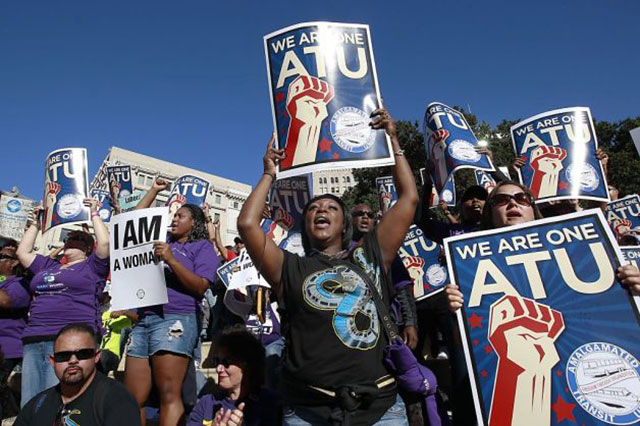
Above: Militant BART workers demonstrated on August 1 in demonstration initiated by Transport Workers Solidarity Committee. Three days later, ATU and SEIU bureaucrats turned union rally into showcase for Democrats. Below: ATU 1555 executive board member Yuri Hollie removed from negotiating committee.
(Photos: Michael Macor/San Francisco Chronicle; Damon Tighe/Flickr)
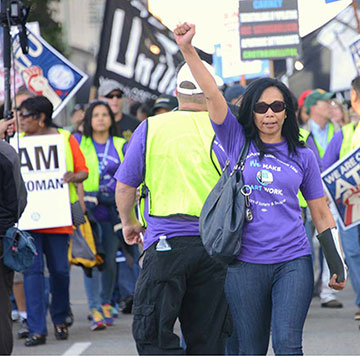 Earlier, when BART workers struck for four
days at the beginning of July, the membership was
mobilized and raring to go. The walkout was 100%
effective, the capitalist media was apoplectic and the
capitalist politicians went berserk. But as the strike was
beginning to hurt Bay Area business, ATU 1555 and SEIU
1021 leaders readily agree to the request by Democratic
governor Jerry Brown to go back for 30 days. On August 1,
some 1,200 workers at BART and AC Transit (whose contract
is also up) as well as labor supporters from around the
Bay Area joined a militant march through downtown Oakland
called by the Transport Workers Solidarity Committee. But
when the 30 days was up a few days later, rather than
striking, this time the BART union leaders asked
Brown to order a 60-day “cooling-off” period!
Earlier, when BART workers struck for four
days at the beginning of July, the membership was
mobilized and raring to go. The walkout was 100%
effective, the capitalist media was apoplectic and the
capitalist politicians went berserk. But as the strike was
beginning to hurt Bay Area business, ATU 1555 and SEIU
1021 leaders readily agree to the request by Democratic
governor Jerry Brown to go back for 30 days. On August 1,
some 1,200 workers at BART and AC Transit (whose contract
is also up) as well as labor supporters from around the
Bay Area joined a militant march through downtown Oakland
called by the Transport Workers Solidarity Committee. But
when the 30 days was up a few days later, rather than
striking, this time the BART union leaders asked
Brown to order a 60-day “cooling-off” period!
When that delaying tactic ran out in October, union leaders continued to dither. To make sure things didn’t get out of hand, ATU national president Larry Hanley ordered the removal of Yuri Hollie, a black and Asian American union militant, from the negotiating committee where she was a lone voice against concessions. (He also removed her as organizer of a union rally which she called for Fruitvale station, in order to tie it to the murder of Oscar Grant by BART police.) ATU Local 192 at AC Transit gave a 72-hour strike notice, but local president Yvonne Williams rejected walking out during a BART strike, reportedly saying that would be “Armageddon.” BART union leaders even begged Democratic Senator Mark Saulnier, who was spearheading calls for outlawing transit strikes, to intercede with BART management. ATU and SEIU leaders brandished the threat of a strike as a bargaining tactic, but they were scared to death of actually waging a knock-down, drag-out fight.
With their backs the wall, the BART union tops felt they had to at least go through the motions. As dawn broke on Friday, October 18 the trains stopped. ATU pickets appeared at the Port of Oakland. Dock workers of the International Longshore and Warehouse Workers Union Local 10 respected the lines, even though the arbitrator (a former top official of the bosses’ Pacific Maritime Association) ruled that picketers couldn’t be outside the gate and the Oakland police chief showed up to intimidate picketers. Non-unionized immigrant port truckers also respected the picket line. One African driver remarked that this is the kind of power we need, and said that the truckers would vote at a meeting on Saturday to stop work Monday.
Yet while ATU 192 members at AC Transit should have gone out together with their sisters and brothers of Local 1555, the bureaucrats in both locals didn’t lift a finger. There were also no pickets at the terminals where extra ferries had been contracted to break the strike. By Friday evening, the union tops managed to put a damper on strike militancy. Left-talking ATU 1555 bureaucrat Chris Finn drove down to the port to tell his members that the picket was illegal, but picketers refused to stand down. He then got ILWU Local 10 president Local 10 President Mike Villeggiante on the phone to repeat the message, blatantly disregarding the longshore union’s historical tradition of labor solidarity. Under fire from all sides, ATU picketers finally gave up.
On Monday, October 21 this shameful scene was repeated even more grotesquely, as port truckers stopped work demanding support for environmental compliance, a fee for waiting time, and an increase in the pay per container, which hasn’t been raised in ten years even as fuel and maintenance costs skyrocket. When the port truckers picketed the SSA Maritime Terminal in the morning, Local 10 longshoremen respected their lines. Truckers’ signs said “ILWU Thanks For Your Support.” But at the 5 p.m. shift, Local 10 president Villeggiante showed up to reportedly scream at the truckers demanding to know what union they were in.1 Local 10 business agent Frank Gaskin drove his car into the line so police could declare the picketers were illegally blocking traffic.
How can you fight to win with leaders like these? In contrast to this disgusting belly-crawling before capitalist legality, a union leadership with a program of class struggle would have defied anti-union laws like the “slave labor” Taft-Hartley Act. Can’t be done? The ILWU did it on May Day 2008 when for the first time in U.S. history it struck against the imperialist war on Iraq and Afghanistan (and in defense of immigrants’ rights). Misleaders like Villeggiante, ILWU International president McEllrath, the ATU’s Hanley and the rest of their bureaucratic buddies act as agents of the bosses within the workers movement. They must be driven out if the unions are to be front-line defenders of working people and the oppressed, or just to win strikes.
A Class-Struggle Program for Strike Action
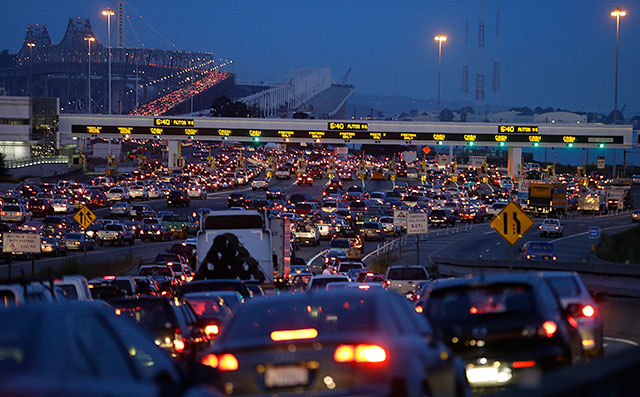
When BART workers walked out at the beginning of July, strike was totally effective. Above: early morning rush hour on the Bay Bridge, July 1. But three and a half months of delaying tactics wore down strike militancy.
(Photo: Ben Margot/AP)
The main thrust of BART’s union-busting strategy was to vilify the unions in the media. Even many BART workers were convinced “the public” was against them. There should have been a huge labor barrage over the bloated pay of managers, like BART chief Grace Cruncian who pulls down $316,000 a year for her “skills” in undercutting safety in the name of “efficiency.” The agency’s highest-price employee is former general manager Dorothy Dugger, who got $333,000 last year for doing nothing at all, on top of a $922,000 “golden parachute.”
Meanwhile, BART’s negotiator Thomas Hock, whose specialty is provoking strikes in order to break them, charged a fee of $399,000 while being absent for weeks and refusing to bargain. Hock, who privatized New Orleans’ transit operations and set off strikes in Tucson, Las Vegas and elsewhere, is a vice president of Veolia Transportation, a notoriously anti-union private bus company, which had a contract with BART to transport passengers during an extended strike and which is currently seeking to break the Boston school bus drivers union.
Then there were the lies about BART workers’ wages. The media claimed that “average” BART union workers earn around $77,000 a year. They came up with this figure by including overtime, fueled by management’s hiring freeze since 2009 even as ridership has nearly doubled; by factoring in part of pension costs, while simultaneously saying employees pay nothing; by including lunch breaks, and other subterfuges. Actually, the median ATU worker’s base pay was $63,000 a year, while hundreds of BART managers rake in triple-digit salaries. And in bellowing about pensions, the media never mentioned the fact that, unlike most workers, BART and other railway workers don’t receive a penny of social security. Their pension is all BART retirees get.
Another issue that the unions should have hammered away at is safety. Since the 2009 contract, BART management slashed operations personnel staff by 8 percent, while during the same period Cal-OSHA reported that injuries in the system have shot up by 43 percent! Literally hundreds of BART workers are injured on the job yearly (see article by John Logan, Labor’s Edge [2 August]).” As for all the talk of need for savings and improving the quality of public transportation, the fact is that BART management was projecting an operating surplus of $125 million a year for the next decade due to increased ridership. The real reason behind their brutal onslaught against transit workers was to break the unions.
To the extent there is declining public support for unions, this is largely because of the failure of labor officialdom to resist the employer offensive of wage slashing, benefit cuts and layoffs. In Wisconsin support for public employee unions skyrocketed the minute they started acting like unions, fighting to defend their members. (Conversely, support fell off after the unions caved in to the Democrats.) After all the propaganda in the business press about the decline of labor, in fact, union membership in California has increased in recent years. If Bay Area labor had stood strong against the union-bashers, they could have won broad backing. But that would have meant waging a very different, class struggle in defense of all working people.
Business-as-usual business unionism like that practiced by the ATU, SEIU and ILWU bureaucrats and the rest of labor officialdom can’t win against a hard-line employer attack. For starters, since BART only a small percentage of mass transit riders in the Bay Area, <>there should have been a joint BART/AC Transit strike backed by all of Bay Area labor. There should have been mass pickets at every BART worksite, big enough and militant enough so no scabs dared to cross. The ferries should have been picketed out, along with Muni barns in San Francisco. The minute an ATU, SEIU or port trucker picket appeared at the docks, the ILWU should have refused to cross and shut down the Port of Oakland. The message should have been driven home: PICKET LINES MEAN DON’T CROSS, PERIOD!
The workers were willing. AC Transit workers repeatedly voted down concessionary contracts presented to them by the ATU 192 tops. ILWU longshore workers respected BART workers’ and port truckers’ pickets until Local 10 officials shamefully ordered them to cross. Against the defeatist whimpering of the union misleaders (following the advice of their lawyers) that you have to “follow the law,” militant workers insist that playing by the bosses’ rules is a losing game – labor’s gotta play hardball to win! There should have been an elected strike committee of all BART and AC Transit unions, with hundreds of delegates elected at every job site, to take charge of the bargaining and counter the sabotage of the labor fakers.
In the face of reprisals, Teamster truckers could have stalled their big rigs on the Cross-Bay and Golden Gate bridges, joined by thousands of labor supporters from throughout the Bay Area to shut down transportation into and out of San Francisco. To win public support, the BART unions should have called not just to lower fares, but to eliminate them: free mass transit, rip out the turnstiles! The striking unions should have joined with low-wage workers demanding a huge raise from their minimum wage jobs. And facing the inevitable repression, BART workers unions should have ostentatiously stood with the family of Oscar Grant, murdered by BART cops, and with black West Oakland against racist police brutality.
Left Apologists for Bureaucratic Sellout
So faced with this union-busting onslaught and a concessionary contract, what was the response of would-be labor militants and self-proclaimed socialists? Labor Notes (23 October) published an article saying BART unions “beat back the worst” and quoting ATU International president Hanley calling the contract “a win in very difficult times.” But then, what else can you expect from and outfit that last year published a how-to guide to negotiating a give-back contract (“How to Bargain Concessions (If You Must),” Labor Notes, May 2012)!
Hanley has been a darling of the Labor Notes crowd and its prime sponsors Solidarity since he was elected as a union “reformer” in 2009. In the bitter month-long New York City school bus strike earlier this year, his contribution was to get Democratic mayoral candidates to send a letter promising to “revisit” the issue, so Local 1181 leaders could call off the strike (see “The Betrayal of the NYC School Bus Strike,” The Internationalist No. 34, March-April 2013).
Interestingly, LN carefully did not call the two engineers killed on the tracks scabs, because they were “not part of the group striking,” even though they were working behind strike lines. Neither did the International Socialist Organization’s Socialist Worker (30 October), which oh-so-politely referred to them as “two people working for BART.” This backhanded excusing of strikebreaking demonstrates how much these pseudo-socialists reflect the degenerated, bourgeois consciousness of labor officialdom. For class-conscious workers, anyone who crosses a picket line or works in a struck facility is a scab. End of story.
The SW article, headlined “Holding the line through picket lines at BART,” was even more effusive in praising the concessionary contract, calling the wage settlement “substantially improved” from management’s original offer and saying that “BART strikers won a small but significant battle.” It even says that the union leaders’ “strategy” of calling on politicians to exert behind-the-scenes pressure “worked in securing a contract that is at least a step forward,” although it recognizes the “danger of relying on Democrats.” (In other words, it’s okay to do it, just don’t rely on them.)
While the writer coyly “asks if the unions could have won more with a more aggressive strategy,” he argues that, “Like the September 2012 Chicago teachers struggle, the BART fight shows that the strike remains the single most powerful weapon in standing up to the kind of union-busting attacks on public-sector workers seen in Wisconsin, Detroit and elsewhere.” Actually, the outcome of the 2012 Chicago teachers strike (in which ISO supporters in the union leadership played a key role) was a disaster, giving in to the demands of corporate education “reformers” on everything from test scores to seniority. As we headlined, “Chicago Teachers: Strike Was Huge, Settlement Sucks” (The Internationalist, September 2012).
But, again, what more can you expect from dyed-in-the-wool reformists like the ISO, who are constantly justifying sellouts by their labor faker friends (and who think the main danger on the left today is “ultra-leftism”). The Spartacist League is a different kettle of fish, sometimes mouthing revolutionary phrases, only to turn around and support the U.S. imperialist invasion of Haiti in January 2010. On the BART strike, the SL’s Workers Vanguard (1 November) says union misleaders “went far more than half way down the road to meet management’s demands for concessions,” but then argues that workers “did not go back with their tails between their legs.” Nothing about voting against the concessionary contact. On the contrary, WV opines: “Nor do many workers think they will get much better under their current union misleaders.”
While WV offers up some good advice from James P. Cannon on how to save the unions and criticizes ATU leaders for looking to the Democrats, it is very reticent about naming names, and attentive readers will notice that the SL put forward no program to win the strike although they have supporters directly involved. This is a repeat the SL’s “posture” in the 2005 NYC transit strike, when it issued a single leaflet with not a word of criticism of TWU Local 100 president Roger Toussaint. WV (9 June 2006) later justified this silence, saying in response to a letter:
“Our posture was to close ranks in defense of the union and its leadership against the bosses and the capitalist state, which were screaming for the head of TWU Local 100 president Roger Toussaint, the leader of the strike. The leaflet did not directly attack Toussaint. Since we could not point to an alternative leadership of the strike, to do so would only have served to weaken the strike.”
So for the SL/WV, “closing ranks” with the union under attack meant not criticizing the sellout leadership! In contrast to this opportunist methodology, the Internationalist Group both defended the strike and the union, while criticizing Toussaint and calling for a class-struggle leadership (see our daily strike bulletins reprinted in The Internationalist No. 23, April-May 2006).
For a Workers Party to Fight for a Workers Government
To defeat the war on workers, workers must respond by waging class war. The bosses have been doing it for decades. Impossible in today’s anti-union political climate? Not at all. Just look at how tens of thousands of working people turned out on 2 November 2011 to shut down the port in protest against the violent police dispersal of Occupy Oakland. No, it wasn’t a general strike, as Occupy claimed, but it sure as hell showed the potential for one. Yet an all-out strike going up against the capitalist class and the capitalist state requires above all a fight to build a class-struggle leadership with a program and the determination to take on hard-nosed bosses, their media and their politicians, Democrat and Republican alike.
As Karl Marx and Friedrich Engels insisted in The Communist Manifesto, “every class struggle is a political struggle.” This is the key lesson of the battle over BART, and it is as true in 2013 as it was 165 years ago. As Marx and Engels wrote, “Now and then the workers are victorious, but only for a time. The real fruit of their battles lies, not in the immediate result, but in the ever expanding union of the workers…. The organization of the proletarians into a class, and, consequently into a political party, is continually being upset again by the competition between the workers themselves. But it ever rises up again, strong, firmer, mightier.”
In the U.S. today, the struggle for a workers party requires first of all breaking with the Democrats. From the White House to the state house and city hall, the Democratic Party has been leading the charge against the unions. Democratic president Obama has spearheaded the attack on teachers unions. As for Jerry Brown, back in 2003 as mayor of Oakland he gave the green light for cops to assault antiwar protesters and longshoremen. Yet ATU, SEIU, ILWU and the rest of labor supported Democrat Brown for governor. And three days after the August 1 march by BART and AC Transit workers, ATU and SEIU leaders turned a union rally into a press conference showcasing Democratic Party politicians. So long as workers are chained to the Democrats, or any capitalist party, they face the prospect of defeat after defeat.
To break with the Democrats, it is necessary to dump the bureaucrats. But class-struggle unionism is not just a more militant version of business unionism, nor is it enough to add a few “social justice” demands to broaden the appeal to “the community.” Holding marches instead of being holed up in back rooms with the bosses won’t win unless those mobilizations are prepared to take on the capitalist parties and defy the capitalist state. Everyone knows it was “reds” who built the unions in the 1930s. The fact is, only a cadre of militants fighting on a revolutionary program can defend the unions and all the oppressed today against the all-sided anti-labor, anti-black, anti-immigrant onslaught of the exploiters and oppressors.
As Leon Trotsky, founder of the Fourth International, wrote in his unfinished 1940 essay “Trade Unions in the Epoch of Imperialist Decay,” the day of reformist unions is gone, because “the objective conditions leave no room for any serious and lasting reforms.” He went on:
“The trade unions of our time can either serve as secondary instruments of imperialist capitalism for the subordination and disciplining of workers and for obstructing the revolution, or, on the contrary, the trade unions can become the instruments of the revolutionary movement of the proletariat….
“As a matter of fact, the independence of trade unions in the class sense, in their relations to the bourgeois state can, in the present conditions, be assured only by a completely revolutionary leadership, that is, the leadership of the Fourth International.”
This is the inescapable truth, as shown once again by the battle over BART. It’s not enough to “occupy” Wall Street, it must be expropriated through socialist revolution. To bring down the dictatorship of capital, we must fight for workers rule. This is the program of the Internationalist Group and the League for the Fourth International. ■
- 1. Truckers are unjustly prohibited from forming a union because they are classified as “independent contractors.”